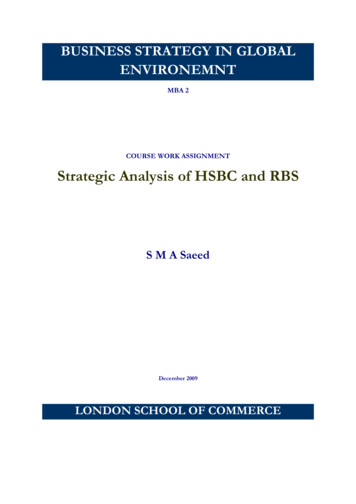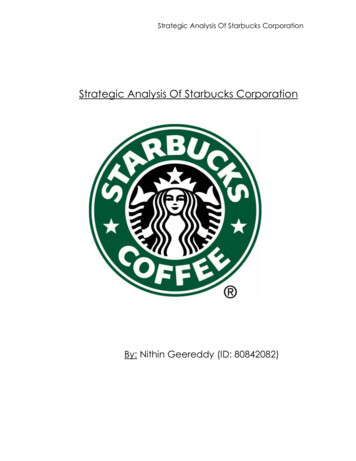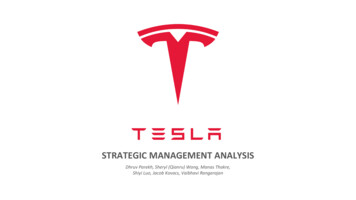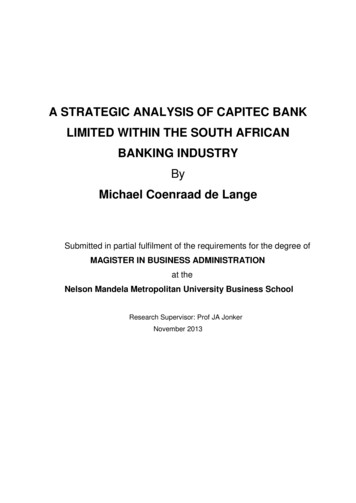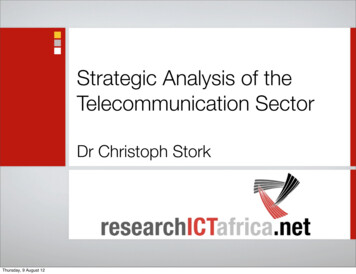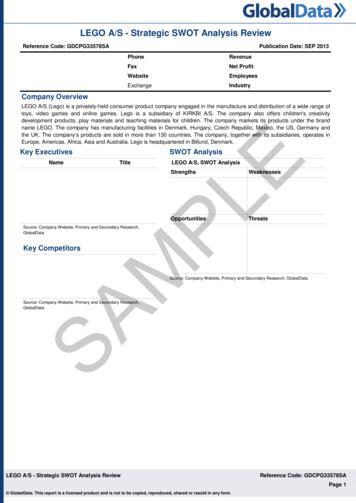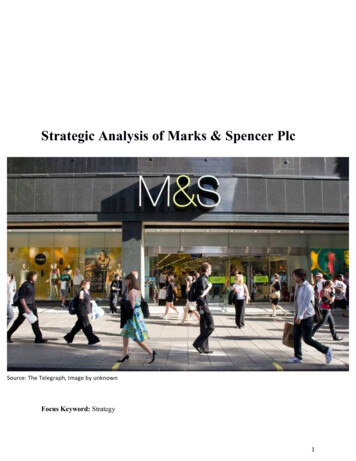
Transcription
Strategic Analysis of Marks & Spencer PlcTitleStrategic business analysis of Marks & Spencer, an iconic BritishDescriptionretailer brand: PESTEL, SWOT, Porter's Five Forces and Value ChainAnalysisKey WordStrategyTextStrategic Analysis of Marks & Spencer PlcSource: The Telegraph, Image by unknownFocus Keyword: Strategy1
Description: Strategic business analysis of Marks & Spencer, an iconic British retailer brand:PESTEL, SWOT, Porter's Five Forces and Value Chain AnalysisContentsI. Company Overview . 4II. Strategic Business Analysis of Marks & Spencer . 5A. PESTEL Analysis . 51. Political Factors . 52. Economic Factors . 63. Socio-Cultural Factors. 64. Technological Factors . 75. Environmental (Ecological) Factors . 76. Legal Factors . 8B. Porter’s Five Forces Analysis . 91. Threat of new entrants (barriers to entry) . 92. Threat of substitute products. 93. Bargaining power of buyers . 104. Bargaining power of suppliers . 105. Intensity of competitive rivalry . 10C. SWOT Analysis . 111. Strengths . 112. Weaknesses . 123. Opportunities . 134. Threats . 14D. Value Chain Analysis . 151. Inbound logistics . 162. Operations . 163. Outbound logistics. 162
4. Marketing and Sales . 175. Service . 17III. Conclusion . 18Bibliography . Error! Bookmark not defined.IntroductionThis paper examines Marks & Spencer Plc - an iconic brand and one of the UK's leadingretailers.A general overview of Marks & Spencer is followed by a PESTEL analysis which offers acomprehensive look at the company’s strategic business environment. An in-depth SWOTanalysis that assesses both the internal (strengths and weaknesses) and external (opportunities andthreats) environment of the company is given. In addition, Porter's Five Forces Analysisdiscusses the industry's competitiveness and the firms' competitive positioning in themarketplace. The paper concludes with a value chain analysis which examines inbound logistics,operations, outbound logistics, marketing, and sales and services.Keywords: M&S; Marks & Spencer; SWOT; PESTEL; Porter’s Five Forces; Strategy; ValueChain Analysis3
I. Company OverviewMarks and Spencer plc was set up in 1884 in Leeds by Michael Marks and re-branded as Marks& Spencer (M&S) ten years later when a partnership with Thomas Spencer was formed. Havingbegun as a market stall, today it is considered to be one of the UK's leading multinational retailerswith over 1,382 stores worldwide, including 468 stores in Eurasia and the Middle East. M&Soffers clothing, home products and luxury food products both in store and online (Marks &Spencer, 2015).The company's 914 UK stores – 222 owned and 349 franchises of Simply Food stores – as wellas the 302 full-line clothing and home stores and an e-commerce platform with over sevenmillion registered users serve 33 million customers in two divisions (food and generalmerchandise) with a revenue of 5.2 billion and 4.0 billion respectively. In the UK market,M&S is a market leader in womenswear, menswear and lingerie. The company's internationalbusiness, which comprises 468 wholly-owned, jointly-owned or franchised stores and spans 59territories in Europe, Asia and the Middle East, had revenue of 1.1 billion in the last financialyear (Marks & Spencer, 2016).During the years of the financial crisis, the company continued its strong ‘brand momentum’ bymaintaining premium pricing and backing it through investments in advertising. Consequentially,the slight decline of sales and share prices in 2008 were followed by steady improvements in boththese indicators a year later, thus escaping the hard to reverse grip of discounted prices felt bymany other competitive retailers (The Marketing Society, 2010). Plan A, the company's social,ethical and environmental business commitments, have also helped the retailer build a strongbrand positioning centred on responsible sourcing, waste reduction and community care (Marks& Spencer, 2016).4
II. Strategic Business Analysis of Marks &SpencerA. PESTEL AnalysisA PESTEL analysis provides a framework toinvestigate a company's non-controllable externalfactors that have the potential to affect its operations.By examining these, a company is in a better position toconsider likely implications and minimise any futureorganisation-related risks (Makos, 2014).1. Political FactorsFigure 1: PESTEL Analysis Framework (Makos, 2014)20142014)According to analysts, M&S has been favourably affected by the European Commission's freetrade agreements which have made product imports much easier (EC, 2013) and have led to adecrease in sourcing costs. However, the run-up to and outcome of the British EU referendum on23 June 2016 resulted in a dip in the company's sales in its last quarter (Davey, 2016). Due to acomparatively higher cost structure, the company has also suffered market share losses whenentering new markets (Marks & Spencer, 2015). In 2015, M&S experienced stalled growth in itsinternational business due to global uncertainties, substandard infrastructure and decreasedprofitability in new markets which lead to the closing of twelve stores in 2016. Geopoliticalunrest also affected the company's overseas operations (Marks & Spencer, 2016). Theinternational franchise businesses of M&S in the Middle East, Russia and Ukraine also sufferedsignificant decline due to geopolitical instability, local currency fluctuations and decreasedconsumer demand (Marks & Spencer, 2015).The company, eponymous with its environmental and ethical ‘Plan A’ green strategy, has alsobeen critical of the lack of clarity in the government’s flagship energy efficiency scheme, thegreen deal, as well as in its shifting green measures legislation. One example is the lack of acharge on plastic carrier bags and how this is affecting the company's efforts to implement5
sustainability measures (Vaughan, 2012).2. Economic FactorsDuring the financial crisis of 2008, while competitors such as Aldi, Asos or Tesco followed astrategy of discounted pricing, M&S emphasised higher quality products and better consumersatisfaction (The Marketing Society, 2010). Whilst this strategy led to a short-term decrease insales, it resulted in a long-term increase in consumer confidence due to British customers'preference and desire to seek both value and quality. In 2015, this strategy helped the companymaintain its market share in most of its markets and achieve strong sales in key owned marketssuch as Hong Kong or India (Marks & Spencer, 2015). Yet, the prolonged financial crisis hasalso increased the price sensitivity of once loyal M&S customers. In addition, in the past coupleof months various macroeconomic issues, falling commodity prices, pound fluctuations and asudden drop following the Brexit vote caused consumer confidence to drop. Further, clothingsales reached a ten-year low in Britain (Davey, 2016) and falling oil prices negatively impactedstores' performance in the Middle East (M&S, 2016).3. Socio-Cultural FactorsTwo external factors that affect the retailer include changing values in the population and ageneration shift – with the Baby Boomer generation retiring, the company has to redirect itsattention to Generation X and the Millennials. Different generations bring perceptible shifts inconsumer behaviour, from the way customers do their shopping, the channels and technologythey use to how products are perceived. Two trends the retailer should take into consideration arethe different generations' customer preferences for fashionable items and/or the growingperception that British produce is no longer considered to be of high quality (Experian, 2015).Green consumerism and customers' ethical concerns about the socio-environmental costs ofbrands they use is one of the factors contributing to the development of companies' sustainabilityreporting and related activities. In the case of M&S, the company has placed considerableemphasis on its social agenda. As stated in its last annual report, and as part of its Plan A, thenow nine-year-old strategic sustainability plan of the company – building relationships withcustomers and suppliers and the communities in which they operate – is essential for the6
company. In 2015, food surpluses were allocated by working with redistribution partners througha ‘Community Shop’ programme, whilst in 2016 a ‘Spark Something Good’ campaign engaged1000 employees in community work and charity action days (Marks & Spencer, 2016).4. Technological FactorsM&S is in a good strategic position to enjoy the benefits of an altering media landscape, theproliferation of social networks and a rising mobile wave. As regards its fashion business, thespeed with which the latest trends are being communicated to designers has increased as has thespeed of transportation. The shopping experience is now largely seamless through the integrationof online, tablet, mobile and the physical experience in the shop (TaylorWessing, 2015). How isthe company reacting?It has moved from a platform hosted by Amazon to its own web platform which was launched atthe end of 2014 to provide more delivery options and streamlined multichannel services. Thecompany has also launched big data projects such as predictive analytics system and allocationreplenishment (Thomson, 2014), adapted its digital strategy using the ‘mobile first approach’ thusanswering the needs of consumers who are increasingly accessing the latest trends via mobile. Adedicated digital lab team of 150 in-house software engineers is working to make sure thecompany stays at the forefront of technological developments (Marks & Spencer, 2016).5. Environmental (Ecological) FactorsWith stricter environmental rules and regulations both at European and international level andincreasing consumer pressure concerning business practices, major international retailers andbrands have to examine the life cycle of its products from cradle to grave – from the suppliers toend usage and disposal – to be completely transparent about their strategic and tacticalenvironmental practices and be fully accountable. Plan A, the environmental and ethical planM&S has adopted to serve as a backbone to the way business is being conducted within andoutside the company, has helped the company stay ahead of the curve by sourcing responsibly,reducing waste and helping stakeholder communities.In 2015 a third of the company's products had been sourced from Gold and Silver sustainability7
standard producers, while another initiative called Shwopping has resulted in 10.6 milliongarments (equating to 7.3 mil
II. Strategic Business Analysis of Marks & Spencer A. PESTEL Analysis A PESTEL analysis provides a framework to investigate a company's non-controllable external factors that have the potential to affect its operations. By examining these, a company is in a better position to consider likely implications and minimise any future



